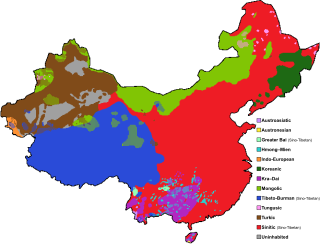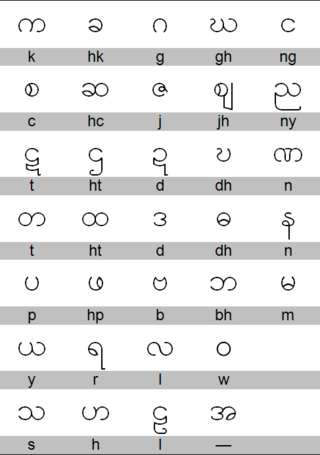
There are several hundred languages in China. The predominant language is Standard Chinese, which is based on Beijingese, but there are hundreds of related Chinese languages, collectively known as Hanyu, that are spoken by 92% of the population. The Chinese languages are typically divided into seven major language groups, and their study is a distinct academic discipline. They differ as much from each other morphologically and phonetically as do English, German and Danish, but meanwhile share the same writing system (Hanzi) and are mutually intelligible in written form. There are in addition approximately 300 minority languages spoken by the remaining 8% of the population of China. The ones with greatest state support are Mongolian, Tibetan, Uyghur and Zhuang.

The Jingpo people are a Southeast Asian ethnic group who are the largest subgroup of the Kachin peoples. The greater name for all the Kachin peoples in their own Jingpo language is the Jinghpaw. Other endonyms include Zaiwa, Lechi, Lisu, Maru, Hkahku, etc.
The Achang language is a Tibeto-Burman language spoken by the Achang in Yunnan, China, and northern Myanmar.

There are approximately a hundred languages spoken in Myanmar. Burmese, spoken by two-thirds of the population, is the official language.
Jinghpaw or Kachin is a Tibeto-Burman language of the Sal branch spoken primarily in Kachin State, Myanmar; Northeast India; and Yunnan, China. The Jinghpaw peoples, a confederation of several ethnic groups who live in the Kachin Hills, are the primary speakers of Jinghpaw language, numbering approximately 625,000 speakers. The term "Kachin language" may refer to the Jinghpaw language or any of the other languages spoken by the Jinghpaw peoples, such as Lisu, Lashi, Rawang, Zaiwa, Lhawo Vo, and Achang. These languages are from distinct branches of the highest level of the Tibeto-Burman family.
Zaiwa is a Burmish language spoken in parts of southwest China and eastern Burma. There are around 100,000 speakers. It is also known as Atsi, its name in Jingpo. Zaiwa may be spelled 'Tsaiva' or 'Tsaiwa', and Atsi may be spelled 'Aci', 'Aji', 'Atshi', 'Atzi' or 'Azi'. Other names include Atsi-Maru, Szi and Xiaoshanhua. Pela (Bola), with 400 speakers, was once classified as a dialect. From the 1950s Zaiwa was written using the Roman script. A Gospel of Mark was published in Zaiwa in 1938 in the Fraser alphabet and in 1951 in the Roman script.

Singpho is a dialect of the Jingpho language spoken by the Singpho people of Arunachal Pradesh and Assam, India. It is spoken by at least 3,000 people. "Singpho" is the local pronunciation of "Jingpho," and the dialect shares 50% lexical similarity with Jingpho.

Tatsuo Nishida was a professor at Kyoto University. His work encompasses research on a variety of Tibeto-Burman languages, he made great contributions in particular to the deciphering of the Tangut language.
The Nung or Nungish languages are a poorly described family of uncertain affiliation within the Sino-Tibetan languages spoken in Yunnan, China and Burma. They include:
Lashi is a Burmish language. Although the endonym Lashi is often used by Western researchers, the people refer to themselves and their language as Lacid. It is according to Nishi in the Maruic branch, which preserves the preglottalized initials of Proto-Burmish in the most phonotactic environments.
Shirō Yabu is a Japanese scholar of the languages of Burma. He is a professor emeritus at Osaka University. He joined the Department of Burmese language of Osaka University in 1982 as an assistant professor and worked there until 2009.
Yoshio Nishi was a Japanese scholar of Tibeto-Burman linguistics.
Tōru Ohno was a Japanese scholar of Burmese. He was an emeritus professor at the Osaka University of Foreign Studies, where he served for many years as chairman of the Burmese department. Graduated from the same university with major in Burmese language. He taught at Osaka University of Foreign Studies from 1965 to 2001 starting his career as an assistant professor.
Lhaovo, also known as Maru (မရူ) and Langsu, is a Burmish language spoken in Burma and by a few thousand speakers in China.
Hpon was a moribund Burmish language spoken by older adults in the gorges of the upper Irrawaddy River of Burma, north of Bhamo. There were two dialects, northern and southern. The language was phonologically more conservative than other 'Kachinised' Burmish languages.
The Kikai language is spoken on Kikai Island, Kagoshima Prefecture of southwestern Japan. It is debated whether it is a single dialect cluster. Regardless, all Kikai dialects are members of the Amami–Okinawan languages, which are part of the Japonic languages.
The Xiandao language is an endangered Burmish language spoken by the Xiandao people who live at the border area between Myanmar and Yunnan, China. It is closely related to the Achang language and is considered by many scholars to be an Achang dialect, due to similarities in syntax and vocabulary. This is one way in which Xiandao can be described. The second is as an independent language due to the social and cultural differences between the Xiandao and Achang people.
Proto-Sino-Tibetan (PST) is the linguistic reconstruction of the Sino-Tibetan proto-language and the common ancestor of all languages in it, including the Sinitic languages, the Tibetic languages, Yi, Bai, Burmese, Karen, Tangut, and Naga. Paul K. Benedict (1972) placed a particular emphasis on Old Chinese, Classical Tibetan, Jingpho, Written Burmese, Garo, and Mizo in his discussion of Proto-Sino-Tibetan.
Izumi Hoshi is a Japanese scholar of Tibetan linguistics at the Tokyo University of Foreign Studies. Born in Chiba, she is the daughter of the equally noted Tibetan linguist Michiyo Hoshi.





